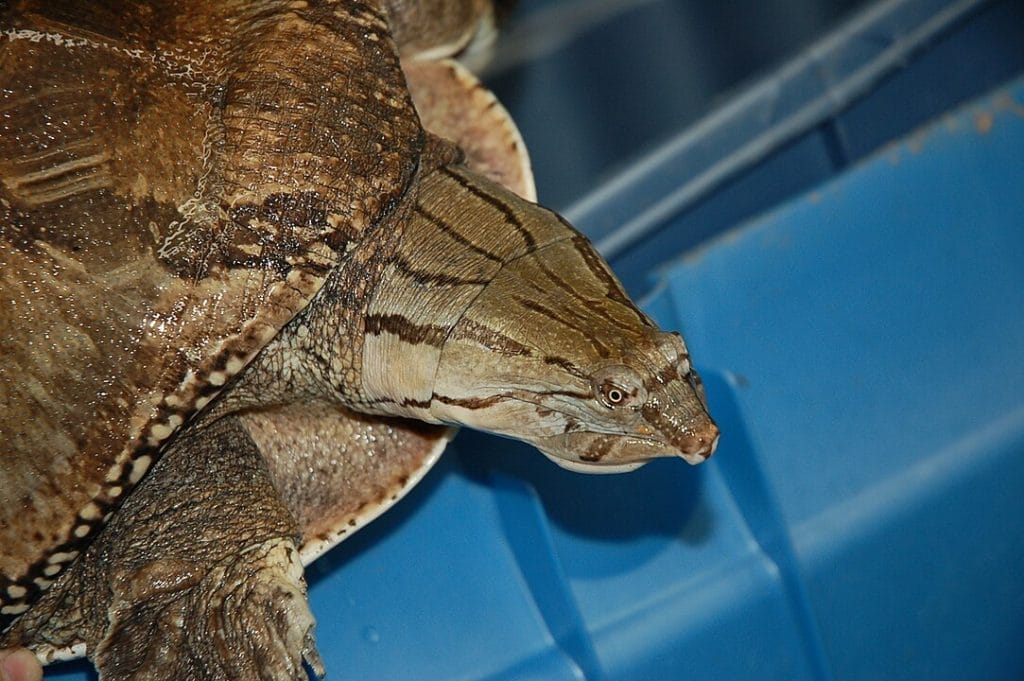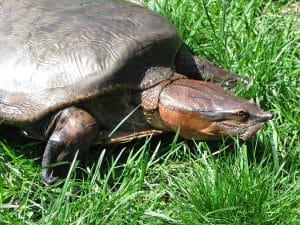Cycloderma frenatum (Zambezi Flapshell Turtle)
Home > Turtle Database > Cycloderma frenatum (Zambezi Flapshell Turtle)

Cycloderma frenatum is a unique freshwater turtle species found in parts of Africa. Known for its smooth, leathery shell, it is adapted to a semi-aquatic lifestyle, primarily in slow-moving rivers and lakes. This species is elusive and has fascinating behavior patterns linked to its aquatic habitat.
Native To These Regions
Angola, Botswana, Malawi, Mozambique, Namibia, Tanzania, Zambia, ZimbabweNative Turtle Species Map – Find Turtles by Region
Scientific Classification
- Kingdom: Animalia
- Phylum: Chordata
- Class: Reptilia
- Order: Testudines
- Family: Trionychidae
- Genus: Cycloderma
- Species: C. frenatum
Common Names
- Zambezi Flapshell Turtle
This Hilarious Turtle Book Might Know Your Pet Better Than You Do
Let’s be real—most turtle care guides feel like reading a textbook written by a sleep-deprived zookeeper.
This one’s not that.
Told from the snarky point of view of a grumpy, judgmental turtle, 21 Turtle Truths You’ll Never Read in a Care Guide is packed with sarcasm, sass, and surprisingly useful insights.
And hey—you don’t have to commit to the whole thing just yet.
Grab 2 free truths from the ebook and get a taste of what your turtle really thinks about your setup, your food choices, and that weird plastic palm tree.
It’s funny, it’s honest, and if you’ve ever owned a turtle who glares at you like you’re the problem—you’ll feel seen.
Identification
- Description: Cycloderma frenatum has a soft, leathery, oval-shaped shell that lacks the hard scutes typical of most turtles. Its coloration varies from olive to grayish brown on the upper shell, while the underside is lighter. It features webbed feet with sharp claws and a distinctive head that retracts into the shell.
- Sexual Dimorphism: Females tend to be larger than males, with males having longer tails in proportion to their body size.
Check more turtles from the Cycloderma genus
Native Origin and Distribution
- Geographical Range: This species is distributed in southern and eastern Africa, particularly in countries like Zambia, Mozambique, and Zimbabwe. It is most commonly found in the Zambezi River basin.
Preferred Habitat
Cycloderma frenatum thrives in slow-moving freshwater environments such as rivers, lakes, and marshes. It prefers areas with soft, muddy substrates where it can easily burrow for camouflage and protection.
Behavior
- Feeding Habits: This turtle is primarily carnivorous, feeding on fish, aquatic invertebrates, and small amphibians. It may also scavenge when necessary.
- Predators: Natural predators include large birds of prey, crocodiles, and certain carnivorous mammals. Juveniles are particularly vulnerable.
Reproduction
- Breeding Season: The breeding season occurs during the wet season, typically from October to December.
- Reproductive Method: Females lay clutches of eggs in sandy or muddy nests near water. The eggs incubate for several months, and hatchlings emerge during the following wet season.
Conservation
- Extinction Status: Currently classified as Least Concern by the IUCN.
- Threats: Habitat destruction due to agricultural expansion, water pollution, and overfishing pose threats to their populations. Some are also captured for local consumption.
- Conservation Measures: Protected areas, habitat conservation efforts, and environmental laws help preserve their populations.
Economic Importance
Cycloderma frenatum is sometimes hunted for its meat in local communities, though it does not have significant commercial importance.
Interesting Facts
- This species can stay submerged underwater for extended periods, using its highly vascularized throat to absorb oxygen.
- Cycloderma frenatum is one of the few softshell turtles that can fold its shell flaps to cover its limbs for protection when threatened.

About Author
Muntaseer Rahman started keeping pet turtles back in 2013. He also owns the largest Turtle & Tortoise Facebook community in Bangladesh. These days he is mostly active on Facebook.












